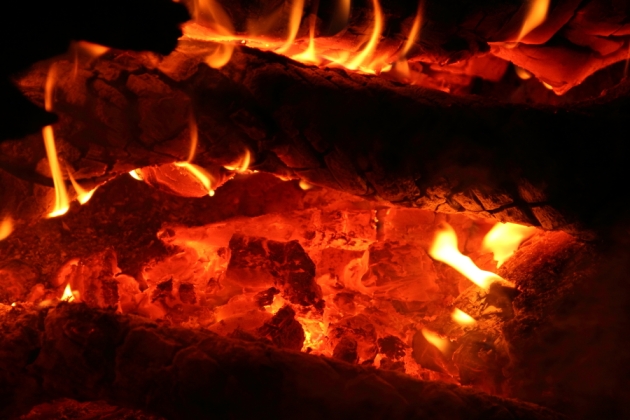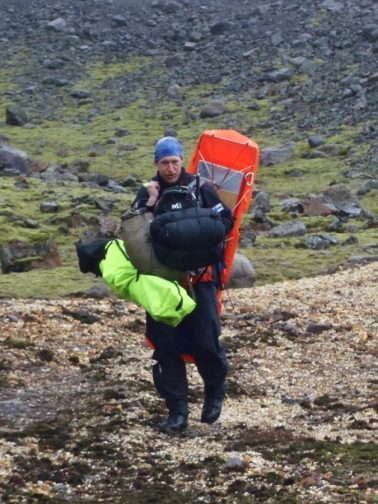What drives a sane person to shiver non-stop for four days and four nights, while not eating or sleeping and call it a holiday?

Editors note: I’m privilege to have extra-ordinary friends who do amazing things. One of them is Huck, a fellow wilderness guide and founder of NordicByNature. He has earlier written quest posts to my blog and as I heard he had just returned from a four-day solo trip with no food and minimal equipment having witnessed the rather early first snow on the way, I again asked for a trip report to share. And as he is a nice guy, he wrote one. here you go! Huck didn’t carry a camera so all the photos are taken and added by me just to make the layout little lighter. All text by Huck. Also feel free to comment or ask, I’m sure Huck will drop by to answer any questions.
Conditions
Location: Hiidenportti National Park
Time: 20.- 24.9.2014
Duration of Solo: 4 days and 4 nights
Weather: rain, snow, wind, temperatures above and below freezing
Distance covered on one meal: 27km
Rules
– same location all time (10m radius)
– avoid sleeping
– no food
– little water (1-2L)
– minimal gear
(isolation mattress, wool blanket, woolen hat, anorak made of old wool blanket, rain poncho, canteen cup. No other cloth.)
Backup
For safety reasons I took with me:
– shelter (tarp, sleeping bag, extra clothing)
– water (an additional two liters plus the potential to melt snow & collect rainwater)
– food (energy rich food)
– stove & tinder (Picogrill wood stove, plenty of fuel, also fatwood found at the location)
– 1st Aid kit
– fully charged phone, map
Background/ motivation
As a wilderness guide and founder of NordicByNature I am offering nature education and nature awareness programs. In cooperation with the Metsäkartano youth center, I am working on the “Natural transition” project, which is aimed to provide an initiation-opportunity to youngsters on the step to adulthood.
In today’s society, social and biological adulthood are not reached at the same age, as it originally should be the case according to human nature. In addition, we do not experience proper initiation into adulthood anymore and have thus often insufficient understanding of our responsibilities, opportunities and roles as members of the global community.
In many indigenous societies, the importance of initiation is better acknowledged and rituals like solos and other challenges mark the transitional phase in this rite of passage.
As I am very interested in initiation rituals and as an intended facilitator/ guide for initiation, I felt obliged to have experienced more than what I would like to provide to young adults.
Preparations
While the opportunity came unexpected, I had been planning to go for a longer solo ever since my solo in 2013.
A few facts played a role in terms of mental and physical preparation.
Having realized the benefits and logic of barefoot walking, I was basically barefoot ever since the last snow in April this year. I also like to dress just a bit colder than cozy and I usually fast for a few days every month. In general I try to live strictly in “need to have” terms instead of “nice to have”. This considers consumption of energy and resources.
Another part of my preparation is a lifelong interest in survival training and survival skills. I am also interested in the physical and mental aspects of initiation rituals such as solos as well as other challenging situations.
Being trained by Wildmed in Wilderness advanced 1st Aid, I was aware of the potential danger that I was going to put myself in. Hypothermia, Dehydration, other cold-related problems and physical injuries were on the list of anticipated problems. For this reason I asked a friend, who is trained to the higher level of “Wilderness First Responder” to walk me out on the last day, bringing with her more energy rich food and also rubberboots.
Another taken precaution was to choose a location for the solo with phone coverage (up on a hill), even though it meant colder temperatures, more snow and more wind. I also shared my position upon arrival and had agreed to report via sms every morning.
From the medical perspective it was good to have a checklist, with pre-set limits for when I would start using the back-up plan or parts of it. With the list I monitored my mood (level of awareness), urine output, skin colour, dexterity of fingers and toes, pulse, and respiratory rate.
Chronology of events
As I spend most of the time sitting or laying, dreaming and thinking, this journey was truly eventful from a psychological point of view. I learned a lot about myself and the rest of nature and had many thoughts and ideas, which let me recommend such an experience to you.
However, in this post I am not going to write about any of this, as the intention is to focus on the physical challenges.

Saturday, 20.9.
Müesli in Joensuu is the last meal for the next days. After breakfast I pack up my stuff and cycle to the end of town, where I leave my bike locked to a tree, hide the key nearby and start hitchhiking towards Nurmes. I had assumed that hitchhiking in my forest cloth, wearing a sarong and no shoes would be difficult and I was right. On the upside I got more rides by single women, as I probably looked very harmless.
In the evening I arrived in Valtimo and started walking towards Peurajärvi, at the southern end of Hiidenportti Nationalpark. After walking about 16 kilometers into the dark without getting any more rides, I went to sleep in my sleeping bag under a little spruce tree.
The weather of the day was nice and sunny but it was getting cold.

Sunday, 21.9.
For the last bit I got a ride from Thai-berrypickers. The interior of the car was super-heated and the guys inside were wearing balaclavas. They didn’t look happy but seemed amused by my leg-wear.
I had looked up a potential area for the solo on my map and started my hike towards it, which took about 4.5 km. On the way I ate half a “Boletus edulis” and a few berries. Near “Pitkä-Portti” I boiled some water, made some chaga tea and went for a swim, to clean myself for the solo.
Temperatures went further down and the air became more moist.
On the last bit of the journey up the near hill I found more tracks and signs of bears and started to become curious if I would have a chance to see some.
At the lake I had made a strong cup of chaga tea in my canteen cup, which I had carried up the hill, drinking small sips and keeping them in my mouth for hours.
I was now almost naked, only wearing a simple anorak that I had made from an old blanket. The night I spend sitting against a tree (I really know her well now).
Shivering had started shortly after my arrival (must have been around noon) and it continued through the night. It was raining all night long. I sat on my isolation mattress, the ends in front and behind me tucked up under the rain poncho. The wool blanket I had folded double to achieve more isolation at the cost of having to make myself really small to fit under.
By the morning some water had leaked in and I sat in a little puddle on my mattress. There was a lot of condensation and the woolen blanket was moist.

Monday, 22.9.
The rain continued the whole day. I went for three little walks around my area and built up my tarp just in case.
The rain stopped in the afternoon and the wind picked up. I estimated the range of a few dead trees in the area in case they would fall in the wind.
After dark it started to snow. The night was colder and it snowed all night. Again I was at the same spot, but had opened the poncho and used it tucked under the mattress, providing a bit more loose cover.
I had hoped for less condensation due to increase ventilation, but the colder temperatures did not help. The blanket was now more moist but still warm. I use the term “warm” very carefully as I was still shivering. In addition to the cold I was getting very tired at night. The nights were very slow.

Tuesday, 23.9.
Snow everywhere. On Monday I had topped up the tea in my canteen cup with rain water.
To allow my blanket to dry a bit, I sat some time under the tarp. Condensation was a real issue in the night and I consider spending the next night under the tarp, which will be less warm but dryer. I have less motivation to move and I am smelling very different as I am now (I guess) the second day in ketosis.
Night sitting and laying under the tarp. Hipbones painful and I have to choose between pain or being cold, as I can make myself small enough to just fit under the doubled blanket when laying on the side.

Wednesday, 24.9.
I likely have slept a bit since the night went faster than the day or the previous nights. No recollection of sleeping, falling asleep or waking up. In the early morning hours I heard wolves to the east.
It’s still snowing wet and the wind is blowing under the tarp. Worried about the dead trees. The night was colder as expected but less condensation.
When getting up I feel very low on energy. Still peeing about three times per day. Very yellow. So far I have used less than a liter since leaving from the lake.
Happy thoughts let me feel warmer and I decide to be happy. In general I feel in good mood and enjoy the experience. More joy than suffering for sure so far.
In the afternoon my friend comes to check on me. We change a few words and she leaves me a pair of rubber boots for the next day. She will camp 1km away from my location on the way out.

Thursday, 25.9.
Night spend under tarp. Coldest night so far. Frost and cold wind from the north. Hips very painful.
Slush-drizzle in the morning. Drinking the last tea, 2L of backup water still untouched. Feeling cold, weak and tired. I allow myself to write down some notes about the last days. When sitting I feel very clear in my head.
Around midday I am slowly getting ready to leave. After standing up I feel very dizzy and have to sit down again. Packing up is slow but I am taking my time to pack properly. The rubberboots seem too heavy and I decide to walk in my backup-shoes. Studying the map I choose a direct route and try to memorize it.
Walking is very slow. I have to look at the ground (I usually use splatter vision) and even when moving slow breathing through my nose is not enough. Moving through the icy snow hurts my legs. I fall a couple of times and feel frequent need to rest. Somehow I walk down a wrong slope and end up in a wrong place. After realizing my navigation mistake (the first in over ten years), I have to walk one kilometer more to get to my friends camp.
When I arrive at the camp I am pale and dizzy. I drink 2L of warm honey water. My toes are white and without feeling. After melting my toes and resting for about an hour or so and having hydrated, I feel better. Also the sun is coming up for the first time of the solo.
My heart rate at departure from the fireplace while standing stationary: 155 bpm.
The last 3km to my friend’s car are better. Breathing through the nose is again possible and no snow is on the ground.

End of Solo
After a quick shop-stop in Valtimo we continue by car to Puukarin Pysäkki, where I clean myself in the sauna. Exhausting.
The food at Puukarin Pysäkki is known to be the best in North Karelia and I couldn’t think of a better place to be. “Feels like heaven” is humming through my head when I sat down at the table, where locally grown organic food has been skillfully prepared for me. Holiday. I take knife and fork in my hands and immediately get cramps in my fingers. Eating is slow and I wished my appetite were bigger. I somehow manage to eat a fair amount but my thirst is overwhelming. I am drinking liters of water, juice, tea, kotikalja.
Night spend at Puukarin Pysäkki. Next day breakfast and hitchhiking back to Joensuu.
On the journey home I ponder about the effects of the solo and about my symptoms from the previous day:
– Compensated volume shock due to dehydration.
– Mild hypothermia.
– Frostnip on toes and parts of both feet.
I am aware that I came close to some limits and wonder how one more day would have affected me.
Conclusion
I can recommend this experience. Being aware of the medical impact such an experience can have is important, as these weather conditions and the set rules can make some people “sail pretty close to the wind”.
Solo’s can, but do not have to be challenging. If you are looking for a physical and mental challenge, I recommend seeking the advice, preparations and assistance of a trained professional.
Solo’s and “vision quests” have a purpose and it’s not a sport. They have great potential to teach you about yourself, your limits, your strength and your role in life. And in my experience this is exactly what they do.
And this is what drives me.
Jaakko Heikka - Professional wilderness guide and diehard outdoor enthusiast with a special interest for lightweight backpacking, arctic expeditions and outdoor photography.

























